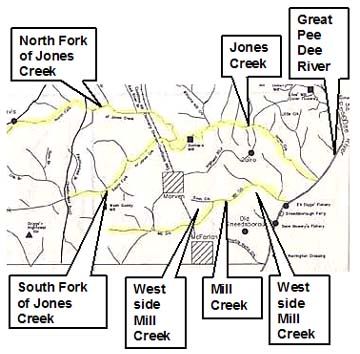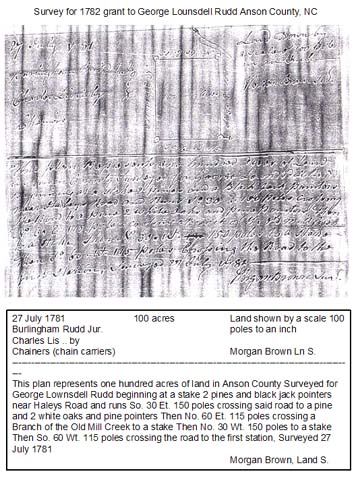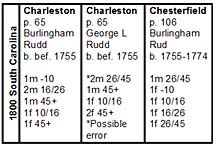
As most of us I think, a lot of “Rudd Cousins” have shared with me many items related to the research of our progenitor. Among those things, I have two items that were done by previous researchers that mention this deed. One of the items is what appears to be a listing of documents and in the margin to the side of this Elizabeth Rudd deed there is a notation that questions if this Elizabeth was the wife of Burlingham 1st.
I don’t think so based on what we now know. The record of the Prince Frederick’s Parish baptism list Martha as born in 1738-9 and as I discussed in Burlingham Rudd vs Burlingham Rudd, there is an indication that George Lounsdell was born before Martha (1738/9). So if Burlingham 1st married wife, Elizabeth, by 1735 and she was at least 18 years old, she would be 82 years old in 1801. I think it’s more likely she’s died by this time. Furthermore, I can’t imagine why George Lounsdell’s mother would have a deed to 100 areas at Old Mill Creek when she would of had her own land upon the death of Burlingham 1st. That last 100 acres was sold by Burlingham 2nd in March 1792.
The other item that was shared with me is a very well written thesis with a lot of helpful information and the conclusion is drawn that this Elizabeth Rudd is the daughter of Burlingham 2nd.
As I’ve said before, the evidence doesn’t support the assumption that the Burlingham Rudd in the 1800 Charelston census is Burlingham 2nd. And there is very strong indication that the Burlingham Rudd who married the widow Mary Whaley is NOT Burlingham 2nd. In the Last Will and Testament of that Burlingham Rudd in St. James Goose Creek he names his daughter, Elizabeth Smith, as his executrix in 1827. So the assumption was made that Elizabeth Rudd and Elizabeth Smith were the same person. And I guess that’s possible but it ignores the fact that this land was origionally granted to George Lounsdell Rudd not Burlingham 2nd.
And that fact was the first thing I noticed when I began to transcribe this deed. This 100 acre tract of land that Elizabeth Rudd is selling to George L. Rudd in 1801 is land that was granted to George Lounsdell Rudd on October 24, 1782. So that raises the question, how did she acquire this land? I’ve not found a deed that documents the land was transferred to her, but she must legally own it if she is legally deeding it back to George Lounsdell. Another question is why is she selling the land?
The second thing I noticed is this deed is witnessed by Burlingham Rudd, who SIGNS his name, and James Rudd, who makes his mark “X”. Now, as I’ve discussed in The Burlingham Rudd who married the Widow Mary Whaley, Burlingham 2nd could not write his name, all his deeds in Anson County, North Carolina bear his mark “X”.
The Burlingham Rudd of St. James Goose Creek, Charleston, South Carolina who married the widow Mary Whaley signs all of those documents with his legal signature. And the Burlingham Rudd who sells land at Four Hole Swamp in 1814 to William H. Harrall signs his legal signature. That land can be tracked back to this Burlingham’s 1813 grant and 1808 survey. Now we have a Burlingham Rudd who appears to be in Charleston who signs his legal signature in 1801 on this Elizabeth Rudd deed. I’m thinking these are the same man and we now can document his presence in Charleston as early as 1801.
Another interesting thing about this deed. The James Rudd who signs his mark as a witness is most likely the son of George Lounsdell Rudd mentioned in the 1797 Screven County, Georgia Deed of Gift Forwarding Stock.
If you missed my critique of that document, you can read it HERE.
What’s of particular interest is that if this is James, the son of George Lounsdell, he wasn’t “of age” in 1797 but by 1801 he is witness to a deed. Did James become “of age” in four years?
Lastly, this deed was then proven in the Anson County July Session of the Court in 1803 by Burlingham Rudd who testifies he was the witness to the deed. The very well written thesis I mentioned earlier draws the conclusion that this is Burlingham 3rd but there is no evidence of that. Actually the statement ...
Then the within deed was duly proven in open court by the oath of Burlingham Rudd as witness thereto ordered to be registered.... indicates that it was the same Burlingham Rudd who witnessed the deed and he then appeared in the Anson County July Session in 1803. The Anson County land deeds reveal that the Burlingham we called 3rd, could not sign his name, he uses the mark "X".
I think that we have another clue here in this statement, almost two years after Elizabeth sells the land to George Lounsdell the deed is then proven in Anson. Well, we know that the 1797 Screven County, Georgia Deed of Gift Fowarding Stock was recorded in Charleston in 1804, so this statement in this Elizabeth Rudd deed seems to indicate that George Lounsdell Rudd died by July 1803 and this deed was proven in Anson as a part of his estate settlement probably because the land was going to be sold. It also makes me wonder if the Burlingham Rudd who witnessed this deed and took it to Anson, was also designated the executor of George Lounsdell’s estate. I’ve always wondered why we have never found any record of a Last Will and Testament for George Lounsdell Rudd. Now I think it’s because he died unexpectedly. Even if he had been first born child of Burlingham 1st, born about 1735-1737, he would have been only 66-68 years old in 1803. I know that sounds old for that day and time, but not from what we know of the longevity of Rudd men back in those days.
Let’s go back to the language in the deed that identifies the location of the land.
beginning at a stake two pines and black jack pointers near Haley’s Road and runs So. 30 Et. 150 poles crossing said Road to a pine and two white oaks and a pine pointers then No. 60 Et. 115 poles crossing a branch of the Old Mill Creek to a stake then No. 30 Wt. 150 poles to a stake then So. 60 Wt. 115 poles crossing the road to the first stationThe Warrant from the land office to the surveyor gives us a little more information about the location of the land.

Notice is says “on the West side of the Creek”. Mill Creek runs from the Great Pee Dee River to the west and very near the border between Anson County in North Carolina and Chesterfield County in South Carolina and according to this map (which is a modern day map and the creek may have changed) you will see the stretch of the creek that turns north then south that would allow for a west side.

Click for Expanded View of Map
On the Survey you’ll see that one of the chainers was Burlingham Rudd, Jr. A chainer is someone who carries the chains for the surveyor in the type of measurement detailed in the deed. I think it’s likely that since this was July 27, 1781 and in Anson County, this is Burlingham 2nd, he would have been about 40 years old at the time. And if so, his calling himself Jr. would indicate that Burlingham 1st was still alive at the time of this survey.

We can see by the documentation provided on the cover sheet to the grant by which this land was acquired by George Lounsdell Rudd that he entered the land into the land office entry book on October 17, 1778. The grant was issued October 24, 1782.

Elizabeth Rudd then sells the land back to George Lounsdell on August 10, 1801, almost 19 years after the issue date. So sometime between 1782 and 1801, Elizabeth Rudd acquired the land from George Lounsdell. She obviously is selling the land because she no longer has any use for it. There’s no way of knowing where this deed was actually physically prepared but my impression is that it was drafted in South Carolina probably in St. James Goose Creek since that is where George Lounsdell had relocated his family by 1800. That’s where James Rudd is located and most likely the Burlingham Rudd that is the other witness is located there as well. I wonder if Elizabeth Rudd had relocated there also.
What are the possibilities of her relationship to George Lounsdell and why would she have possession of this 100 acre tract of land granted to him in 1782?
Is Elizabeth Rudd ...
1) An unmarried daughter of George Lounsdell?
2) An unmarried sister of George Lounsdell?
3) The widow of a son of George Lounsdell?
4) An unmarried niece of George Lounsdell and perhaps her father, his brother, died?
5) The widow of a brother of George Lounsdell?
But like I said earlier, I think we can rule out that this Elizabeth is George Lounsdell’s mother. Perhaps she is the daughter of the Burlingham who married Mary Whaley (who, by the way, is not Burlingham 2nd), if that Burlingham is also directly related to George Lounsdell and this land somehow went from George Lounsdell to the Burlingham who married the widow Mary Whaley to this Elizabeth Rudd.
I would be remiss if I didn’t include another twist to our mystery. It surely adds to the confusion, but I don’t think we should exclude information when we’re trying to work through an analysis. I think that type of practice has not served us well in understanding the larger family and how we all fit together.
Based on the scale on this map of 1”=3 miles, that stretch of Mill Creek where it turns north and then south that would allow for a “west side of the creek” and is approximately 6 miles from the NC SC border. In the 1800 Chesterfield, South Carolina census we have yet another Burlingham Rudd.
He is indexed in the 1800 Census Index Book as Reed, but he’s Rudd as you can clearly see. You’ll notice this Burlingham says he is born between 1755 and 1774, a wife in his same age group and what appear to be three daughters, the oldest at least 16 years old. So working backwards, in 1800 a 16 year old daughter was born in 1784 and if her father was at least (18 when he married and) 19 at the time of her birth, he would have been born about 1765, if she is older or he’s older then he’s born before 1765.
This gives us another unidentified Burlingham who appears to be a son of a son of Burlingham 1st so we have three 1800 Burlingham Rudd households!

I’m beginning to believe the only way to reconstruct the early family in Anson will be to gather as many land deeds for adjoining property as possible and buy the software that will plot the land using the meters and bounds system. We’re lucky that the Anson County land records include that information.
And Thanks Cousin Rodney for the Anson County Map!!

No comments:
Post a Comment